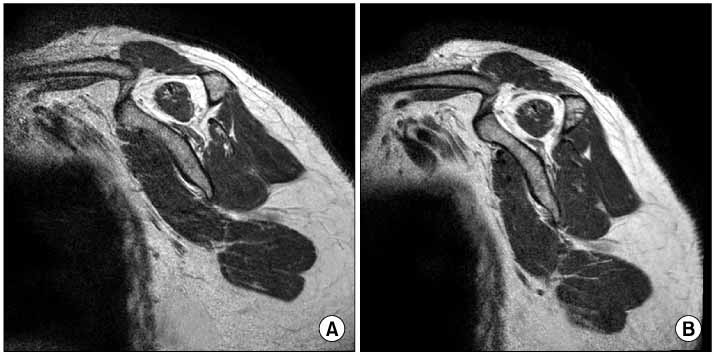J Korean Orthop Assoc.
2009 Oct;44(5):556-564. 10.4055/jkoa.2009.44.5.556.
Analysis of the Change in Fatty Degeneration of the Rotator Cuff and Its Influence on the Outcome of Rotator Cuff Repair
- Affiliations
-
- 1Department of Orthopedic Surgery, Asan Medical Center, Ulsan University College of Medicine, Seoul, Korea. jbpark2@gmail.com
- KMID: 2186316
- DOI: http://doi.org/10.4055/jkoa.2009.44.5.556
Abstract
- PURPOSE
To analyze the changes in fatty degeneration of the rotator cuff after its repair as well as the effect of fatty degeneration on the functional and anatomical outcomes. MATERIALS AND METHODS: The medical records of 107 patients (mean age=58.7 years), who had undergone a repair of rotator cuff tears, were reviewed. The mean follow-up period was 16 months. The following parameters were evaluated: the functional outcomes, including the American shoulder and elbow surgeons (ASES) score, Constant score and muscle power; preoperative and postoperative fatty degeneration of the rotator cuffs, including supraspinatus, infraspinatus and subscapularis; and the cuff integrity. RESULTS: Both the ASES and Constant scores were improved significantly postoperatively. The re-tear rate was 19.6%. The overall rate of satisfactory results was 88.8%. Fatty degeneration progressed in 25 cases (22.4%) and regressed in three (2.8%). More progression was observed in older (p=0.016) and re-tear (p=0.011) patients. The ASES score had a significant relationship with the preoperative fatty degeneration of the supraspinatus and the infraspinatus, whereas the Constant score was associated with the fatty degeneration of all three muscles. CONCLUSION: Greater progression of fatty degeneration was observed in older and re-tear patients. The functional outcomes were better in the less severe fatty degeneration group.
Figure
Cited by 1 articles
-
Follow-up Results in Patient with the Progressive Fatty Degeneration of the Rotator Cuff
Jae-Bum Park, Hong Jun Jung, Tae Soo Ahn, Jae Myeung Chun
J Korean Orthop Assoc. 2011;46(1):28-34. doi: 10.4055/jkoa.2011.46.1.28.
Reference
-
1. Goutallier D, Postel JM, Bernageau J, Lavau L, Voisin MC. Fatty muscle degeneration in cuff ruptures. Pre- and postoperative evaluation by CT scan. Clin Orthop Relat Res. 1994. (304):78–83.2. Gerber C, Walch G. Massive rotator cuff tears. 2002. Rosemont: American Academy of Orthopaedic Surgeons;191–196.3. Gladstone JN, Bishop JY, Lo IK, Flatow EL. Fatty infiltration and atrophy of the rotator cuff do not improve after rotator cuff repair and correlate with poor functional outcome. Am J Sports Med. 2007. 35:719–728.
Article4. Oh JH, Kim SH, Ji HM, Jo KH, Bin SW, Gong HS. Prognostic factors affecting anatomic outcome of rotator cuff repair and correlation with functional outcome. Arthroscopy. 2009. 25:30–39.
Article5. DeOrio JK, Cofield RH. Results of a second attempt at surgical repair of a failed initial rotator-cuff repair. J Bone Joint Surg Am. 1984. 66:563–567.
Article6. Zanetti M, Hodler J. MR imaging of the shoulder after surgery. Radiol Clin North Am. 2006. 44:537–551.
Article7. Goutallier D, Postel JM, Gleyze P, Leguilloux P, Van Driessche S. Influence of cuff muscle fatty degeneration on anatomic and functional outcomes after simple suture of full-thickness tears. J Shoulder Elbow Surg. 2003. 12:550–554.
Article8. Zanetti M, Gerber C, Hodler J. Quantitative assessment of the muscles of the rotator cuff with magnetic resonance imaging. Invest Radiol. 1998. 33:163–170.
Article9. Shen PH, Lien SB, Shen HC, Lee CH, Wu SS, Lin LC. Long-term functional outcomes after repair of rotator cuff tears correlated with atrophy of the supraspinatus muscles on magnetic resonance images. J Shoulder Elbow Surg. 2008. 17:Suppl. 1–7.
Article10. Oh JH, Kim SH, Choi JA, Kim Y, Oh CH. Reliability of the grading system for fatty degeneration of rotator cuff muscles. Clin Orthop Relat Res. 2008. Published online April 5, 2009; doi:10.1007/s11999-009-0818-6.
Article11. Rubino LJ, Sprott DC, Stills HF Jr., Crosby LA. Fatty infiltration does not progress after rotator cuff repair in a rabbit model. Arthroscopy. 2008. 24:936–940.
Article12. Goutallier D, Postel JM, Radier C, Bernageau J, Zilber S. Long-term functional and structural outcome in patients with intact repairs 1 year after open transosseous rotator cuff repair. J Shoulder Elbow Surg. 2009. 18:521–528.
Article13. Liem D, Lichtenberg S, Magosch P, Habermeyer P. Magnetic resonance imaging of arthroscopic supraspinatus tendon repair. J Bone Joint Surg Am. 2007. 89:1770–1776.
Article14. Zingg PO, Jost B, Sukthankar A, Buhler M, Pfirrmann CW, Gerber C. Clinical and structural outcomes of nonoperative management of massive rotator cuff tears. J Bone Joint Surg Am. 2007. 89:1928–1934.
Article15. Mochizuki T, Sugaya H, Uomizu M, et al. Humeral insertion of the supraspinatus and infraspinatus. New anatomical findings regarding the footprint of the rotator cuff. Surgical technique. J Bone Joint Surg Am. 2009. 91(Pt 1):Suppl 2. 1–7.16. Mellado J, Calmet J, Olona M, et al. Surgically repaired massive rotator cuff tears: MRI of tendon integrity, muscle fatty degeneration, and muscle atrophy correlated with intraoperative and clinical findings. AJR Am J Roentgenol. 2005. 184:1456–1463.
Article17. Goutallier D, Postel JM, Bernageau J, Lavau L, Voisin MC. Fatty infiltration of disrupted rotator cuff muscles. Rev Rhum Engl Ed. 1995. 62:415–422.18. Burkhart SS, Barth JR, Richards DP, Zlatkin MB, Larsen M. Arthroscopic repair of massive rotator cuff tears with stage 3 and 4 fatty degeneration. Arthroscopy. 2007. 23:347–354.
Article
- Full Text Links
- Actions
-
Cited
- CITED
-
- Close
- Share
- Similar articles
-
- Revisional Rotator Cuff Repair
- Follow-up Results in Patient with the Progressive Fatty Degeneration of the Rotator Cuff
- Controversy in Pathophysiology of Rotator Cuff Tear: Degenerative Tear
- Biological Characteristics of Rotator Cuff Tendon
- Delaminated Rotator Cuff Tear: Concurrent Concept and Treatment


